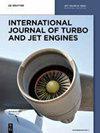Gas dynamic analysis of the modern single shaft gas turbine engine flow path
IF 0.9
4区 工程技术
Q4 ENGINEERING, AEROSPACE
引用次数: 0
Abstract
Abstract The paper outlines a finite volumes refined mathematical model of the working gas flow in the flow path of the three stage modern single shaft gas turbine engine that can be used in floating power plants. Such mathematical model based on the finite volumes of hexagonal-type was constructed using the three-dimensional Navier–Stokes equations for the case of viscous working fluid flow. For the problem solution such boundary conditions as “inlet’, “outlet” and “wall” have been used. The calculation is carried out in a non-stationary setting with a time step of 1.5974 × 10−6 s, which corresponds to the angle of rotation of the rotor, relative to the stator, of 0.09°. The total number of time iterations is 350. Also, it was shown that the variation field of pressure on the blades feather surfaces and the gas flow velocity due to rotation are the critical factors, causing the blades vibration. The result was confirmed with the experiment. The obtained results would be used as a base for further investigations of gas flow pressure field on the blades surface, because the gas flow pressure are key factors, causing the rotor forced vibration, and as initial data for their fatigue strength and crack study.现代单轴燃气轮机流道气体动力学分析
摘要本文建立了可用于浮动电站的三级现代单轴燃气轮机流道内工作气流的有限体积精细数学模型。针对粘性工质流动,采用三维Navier-Stokes方程,建立了基于六边形有限体积的数学模型。对于问题的求解,采用了“入口”、“出口”和“壁面”等边界条件。计算是在非平稳设置下进行的,时间步长为1.5974 × 10−6 s,对应于转子相对于定子的旋转角度为0.09°。时间迭代的总次数是350。结果表明,叶片羽面压力的变化场和旋转引起的气流速度是引起叶片振动的关键因素。实验结果证实了这一结论。所得结果可作为进一步研究叶片表面气体流动压力场的基础,因为气体流动压力是引起转子强迫振动的关键因素,也是叶片疲劳强度和裂纹研究的初始数据。
本文章由计算机程序翻译,如有差异,请以英文原文为准。
求助全文
约1分钟内获得全文
求助全文
来源期刊

International Journal of Turbo & Jet-Engines
工程技术-工程:宇航
CiteScore
1.90
自引率
11.10%
发文量
36
审稿时长
6 months
期刊介绍:
The Main aim and scope of this Journal is to help improve each separate components R&D and superimpose separated results to get integrated systems by striving to reach the overall advanced design and benefits by integrating: (a) Physics, Aero, and Stealth Thermodynamics in simulations by flying unmanned or manned prototypes supported by integrated Computer Simulations based on: (b) Component R&D of: (i) Turbo and Jet-Engines, (ii) Airframe, (iii) Helmet-Aiming-Systems and Ammunition based on: (c) Anticipated New Programs Missions based on (d) IMPROVED RELIABILITY, DURABILITY, ECONOMICS, TACTICS, STRATEGIES and EDUCATION in both the civil and military domains of Turbo and Jet Engines.
The International Journal of Turbo & Jet Engines is devoted to cutting edge research in theory and design of propagation of jet aircraft. It serves as an international publication organ for new ideas, insights and results from industry and academic research on thermodynamics, combustion, behavior of related materials at high temperatures, turbine and engine design, thrust vectoring and flight control as well as energy and environmental issues.
 求助内容:
求助内容: 应助结果提醒方式:
应助结果提醒方式:


